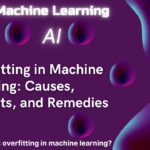what is overfitting in machine learning?
Introduction
In the dynamic landscape of machine learning, overfitting is a phenomenon that can hinder the effectiveness of predictive models and compromise their generalization abilities. Understanding overfitting is paramount for data scientists and machine learning practitioners, as it can mean the difference between a model that performs well on unseen data and one that fails to deliver accurate predictions. In this in-depth exploration, we will delve deep into the intricacies of overfitting in machine learning, uncovering its root causes, consequences, and a range of strategies to mitigate its effects.
Chapter 1: Demystifying Overfitting
Defining Overfitting:
Overfitting is a common pitfall in machine learning where a model learns to perform exceptionally well on the training data, but fails to generalize to new, unseen data. The model becomes too tailored to the peculiarities of the training dataset, capturing noise and outliers that are not representative of the underlying patterns.
Chapter 2: Understanding the Causes
Complexity and Flexibility:
Overfitting often arises when a model becomes too complex, having more parameters than necessary to describe the underlying patterns. Highly flexible models can fit noise in the data, leading to poor generalization.
Insufficient Data:
A small dataset may not contain enough diverse examples to capture the true underlying distribution. In such cases, the model might resort to memorizing the training data, leading to overfitting.
Chapter 3: Recognizing the Symptoms
Training Performance vs. Generalization:
One of the clearest signs of overfitting is when a model exhibits excellent performance on the training data but struggles to produce accurate predictions on new data.
Erratic Validation Performance:
If the validation performance of a model fluctuates dramatically across different subsets of data, it could indicate overfitting.
High Variance in Model Outputs:
Models suffering from overfitting may produce wildly varying outputs for similar input data points.
Chapter 4: Implications of Overfitting
Poor Generalization:
Overfit models fail to generalize to new data, rendering their predictions inaccurate and unreliable.
Wasted Resources:
Building and training overfit models consumes computational resources and time without yielding valuable insights.
Missed Opportunities:
An overfit model may not uncover meaningful relationships in the data, missing out on opportunities for discovery.
Chapter 5: Strategies to Combat Overfitting
Cross-Validation:
Cross-validation involves partitioning the dataset into multiple subsets and training the model on different combinations of these subsets. This provides a more accurate estimate of the model’s performance on unseen data.
Regularization:
Regularization techniques, such as L1 and L2 regularization, introduce penalties on the model’s parameters, discouraging them from reaching extreme values. This helps prevent overfitting by merchandising simplicity.
Feature Selection:
Choosing relevant features and discarding irrelevant ones reduces the complexity of the model and mitigates the risk of overfitting.
Ensemble Methods:
Ensemble methods, like Random Forests and Gradient Boosting, combine the outputs of multiple models, enhancing generalization by averaging out individual errors.
Early Stopping:
Monitoring the performance of the model on a validation set and stopping the training process when the performance starts degrading can prevent the model from fitting noise.
Chapter 6: Striking the Balance
Bias-Variance Tradeoff:
Overfitting and underfitting (lack of model complexity) are two ends of a spectrum. The goal is to strike the right balance between the two by managing bias and variance.
Chapter 7: Real-World Applications
Medical Diagnosis:
In medical diagnosis, an overfit model might incorrectly predict certain conditions based on idiosyncrasies in the training data, leading to misdiagnosis.
Financial Predictions:
In financial markets, an overfit model could predict stock prices based on random fluctuations in historical data, leading to poor investment decisions.
Image Recognition:
An overfit model in image recognition could memorize specific image samples, failing to identify new images accurately.
Chapter 8: Future Challenges and Emerging Solutions
Complex Data:
As datasets become more complex and high-dimensional, the risk of overfitting amplifies. Novel techniques are required to handle such data effectively.
Interpretable AI:
Striking a balance between model complexity and interpretability remains a challenge, especially as models grow more sophisticated.
Conclusion
Overfitting, a common phenomenon in machine learning, is a significant obstacle to creating robust predictive models. Understanding its causes, symptoms, and consequences is vital for any practitioner aiming to build models that generalize well to new data. The strategies discussed in this guide offer a toolkit to combat overfitting and achieve a delicate balance between capturing patterns and avoiding noise. As machine learning evolves, the battle against overfitting remains a central concern, driving researchers and practitioners to develop innovative solutions and ensure the efficacy of machine learning models across diverse applications.










